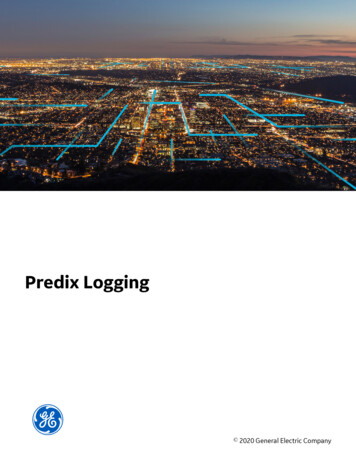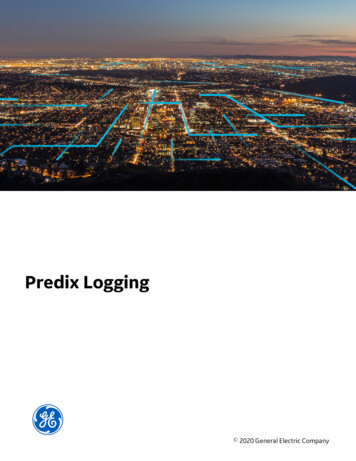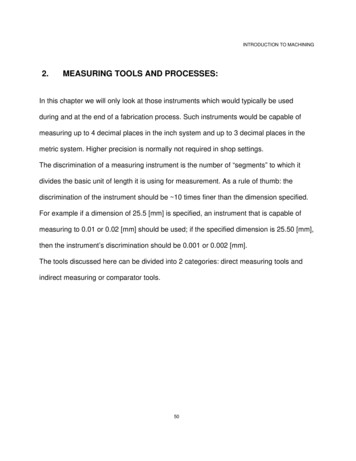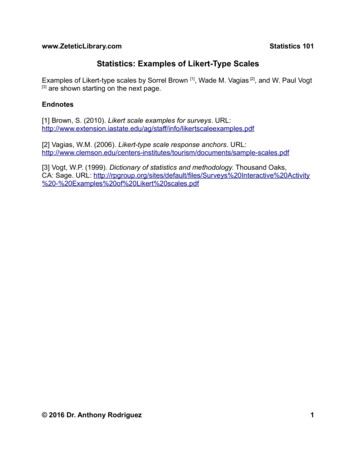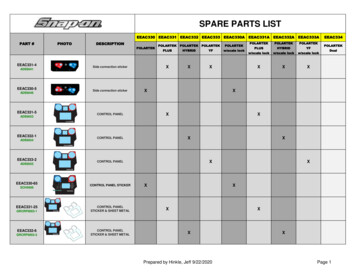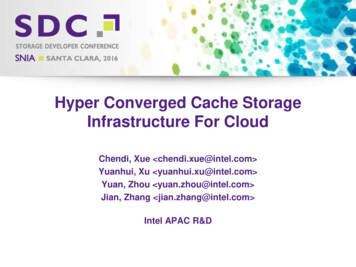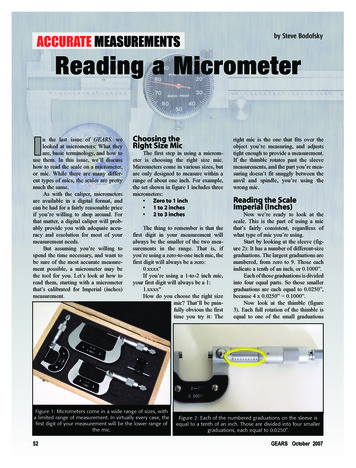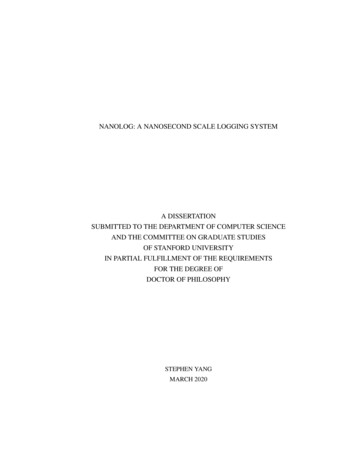
Transcription
NANOLOG: A NANOSECOND SCALE LOGGING SYSTEMA DISSERTATIONSUBMITTED TO THE DEPARTMENT OF COMPUTER SCIENCEAND THE COMMITTEE ON GRADUATE STUDIESOF STANFORD UNIVERSITYIN PARTIAL FULFILLMENT OF THE REQUIREMENTSFOR THE DEGREE OFDOCTOR OF PHILOSOPHYSTEPHEN YANGMARCH 2020
2020 by Stephen Yang. All Rights Reserved.Re-distributed by Stanford University under license with the author.This work is licensed under a Creative Commons AttributionNoncommercial 3.0 United States 3.0/us/This dissertation is online at: http://purl.stanford.edu/pd423tg1235ii
I certify that I have read this dissertation and that, in my opinion, it is fully adequatein scope and quality as a dissertation for the degree of Doctor of Philosophy.John Ousterhout, Primary AdviserI certify that I have read this dissertation and that, in my opinion, it is fully adequatein scope and quality as a dissertation for the degree of Doctor of Philosophy.Mendel RosenblumI certify that I have read this dissertation and that, in my opinion, it is fully adequatein scope and quality as a dissertation for the degree of Doctor of Philosophy.Matei ZahariaApproved for the Stanford University Committee on Graduate Studies.Stacey F. Bent, Vice Provost for Graduate EducationThis signature page was generated electronically upon submission of this dissertation inelectronic format. An original signed hard copy of the signature page is on file inUniversity Archives.iii
AbstractInstrumentation is fundamental to developing and maintaining applications in the modern datacenter. It affords visibility into what an application is doing at runtime, and it helps pin-point bugs ina system by exposing the steps that lead to an error. The most common method of instrumentation today is logging, or printing out human-readable messages during an application’s execution.Unfortunately, as applications have evolved to become increasingly more performant with tighterlatency requirements, traditional logging systems have not kept up. As a result, the cost of producinghuman-readable log messages is becoming prohibitively expensive.NanoLog is a nanosecond scale logging system that’s 1-2 orders of magnitude faster than existing logging systems such as Log4j2, spdlog, Boost log, or Event Tracing for Windows. The systemachieves a throughput of up to 82 million log messages per second for simple log messages andhas a typical log invocation overhead of 8 nanoseconds. For comparison, other modern logging applications today can only achieve up to a few million log messages per second at log latencies ofhundreds of nanoseconds to several microseconds.NanoLog achieves its ultra-low latency and high throughput by shifting work out of the runtimehot-path and into the compilation and post-execution phases of the application. More specifically,it performs compile-time extraction of static information from the log messages to reduce I/O anddecouples formatting of the log messages from the runtime application by deferring it until afterexecution. The result is an optimized runtime that only outputs the minimal amount of data andproduces a compact, binary log file. The binary log file is also amenable to log analytics engines; itis small relative to full, human-readable log messages and contains all the data in a binary format,saving the engine from parsing ASCII text. With these enhancements, NanoLog enables nanosecondscale logging and hopes to fill the performance gap left between traditional logging systems of todayand the next generation applications of tomorrow.iv
AcknowledgmentsWhen I first started the PhD program, I had no idea what the journey entailed or even how to getstarted. But thanks to a few key people in my life, I was able to navigate the landscape and graduatewith this dissertation and degree in hand.First and foremost, I would like to thank John Ousterhout for being my primary advisor for thepast couple of years. He’s guided me through becoming a better engineer, a better scientist, andmore importantly, a better person. He’s always supported my work, whether it be with him or othergroups outside his lab. He’s taught me how to analyze problems in ways that generalize beyond justresearch, and he’d always make time to meet when I needed1 . He’s allowed me to find and pursuemy own hobbies and interests during the PhD program and even supported me for conferencesoutside his area of research. We’d often see eye-to-eye on many things in our meetings, but even ifwe don’t, we’d often agree on how to disagree. When I am with John, I don’t feel like I work forJohn, but rather I work with John. It’s been a long journey, and I have learned a lot. Thanks John.Also thank you to my committee members, Matei Zaharia, Mendel Rosenblum, Mac Schwager,and Dawson Engler for both providing feedback on my work and attending my thesis defense.Special thanks to Mendel Rosenblum for coming into our office every week and sharing insightfulanecdotes from the industrial world. It helps the lab stay grounded and aware of the world outsideour office’s four walls (well, three regular walls and one glass wall).Additionally, thank you Wendy Ju and Michael Bernstein for supporting my brief detour into theMechanical Engineering Department. Thank you, Wendy for introducing me to the area of HumanRobot Interaction and having the patience to deal with my lack of expertise in the new field. Thework we’ve done together has taught me a lot and expanded my scope as a researcher. It’s unfortunate that none of the research with you two made it into this dissertation, but I’m glad I was able1 Andequally important, allowed meetings to be canceled when they weren’t.v
to help [14, 38, 39, 52, 53, 72] (Also, thank you for hosting the hot chocolate parties with the othergraduate students at your house).Thanks to my labmates, old and new, for their help and support in everything. Ryan Stutsman,you’re an inspiration, and the stories of how you navigated your undergraduate education were aweinspiring. Diego Ongaro, you’re a cool dude. Steve Rumble, you are amazing with your codingskills, whether you realize it or not. Ankita Arvind Kejriwal, thanks for introducing me to yourfriends when I first arrived at Stanford, for inviting me to dinners (despite my voracious hunger fornon-vegetarian food at the time), and for bringing me on to your research project; that last one wasa SLIK move. Thank you, Henry Qin for all the non-vegetarian dinners and trips to Fremont, CAfor good food. Thank you, Seo Jin Park for instrumenting Event Tracing for Windows and helpingme pursue janky DIY projects. Collin Lee, thank you for the dinners, the cool stories, and guidanceon actual engineering (unlike Super Jank Park’s projects). Finally, thank you to Behnam Montazeriand Jonathan Ellithorpe for just being in lab everyday. It was nice to know that whenever I cameinto lab, there was always a friendly face around to greet me.Thank you to my undergraduate friends who have made trips up to the Bay Area to visit me.Thank you Michael Wayne Li and David Dinh for inviting me on trips (and sometimes paying forthem p). Thank you, Adrián Galván for helping me move up to the Bay Area and helping me adjustto the new area. And thank you everyone else for being around when I come back to visit (you knowwho you are).Thank you to my undergraduate research advisors at the University of California, Irvine forputting me on the PhD track. Thank you, Brian Demsky, for supporting my undergraduate research,including me in the Dynamic Out-of-Order Java work, and trying so hard to convince me to branchoutside of UCI (it worked). Thank you, Tony Givargis, for providing support and guidance duringmy summer research and connecting me with other researchers.Finally, thank you, fair reader, for starting this dissertation. It’s a long one, but it representsthe cumulation of everything I’ve learned about low-latency systems. In it, you’ll not only find adescription of NanoLog, but also tidbits of arcane knowledge like C 17 metaprogramming andCPU cache designs. I hope you enjoy.vi
Industrial Response To NanoLogWhen I claim NanoLog can produce up to 82 million log messages per second with a medianinvocation latency of 7-19 nanoseconds, industrial affiliates typically respond with an expressionsimilar to Figure 12 .2 The image was created by user Sonitaaaaa on Wikimedia Commons and distributed under Creative CommonsAttribution-Share Alike 4.0 International [56].vii
Figure 1: Caricature of the typical industrial response to NanoLog.viii
ContentsAbstractivAcknowledgmentsvIndustrial Response To NanoLogviiContentsixList of tablesxiiiList of figuresxiv1Introduction12Background and Motivation42.1The API . . . . . . . . . . . . . . . . . . . . . . . . . . . . . . . . . . . . . . . .42.2Techniques to Speed Up Logging . . . . . . . . . . . . . . . . . . . . . . . . . . .42.3NanoLog’s Observations . . . . . . . . . . . . . . . . . . . . . . . . . . . . . . .634Overview73.1Key Techniques and Optimizations . . . . . . . . . . . . . . . . . . . . . . . . . .73.2Architecture . . . . . . . . . . . . . . . . . . . . . . . . . . . . . . . . . . . . . .83.3The Two Versions of NanoLog . . . . . . . . . . . . . . . . . . . . . . . . . . . .103.4Dissertation Outline . . . . . . . . . . . . . . . . . . . . . . . . . . . . . . . . . .10Front End114.115Implementations . . . . . . . . . . . . . . . . . . . . . . . . . . . . . . . . . . .ix
4.2Preprocessor NanoLog . . . . . . . . . . . . . . . . . . . . . . . . . . . . . . . .154.2.1Preprocessor NanoLog Architecture . . . . . . . . . . . . . . . . . . . . .15Preprocessor Challenges and Implementation Details . . . . . . . . . . . . . . . .194.3.1Interposing on Compilation . . . . . . . . . . . . . . . . . . . . . . . . .194.3.2Identifying the Log Statements . . . . . . . . . . . . . . . . . . . . . . . .214.3.3Generating the Functions . . . . . . . . . . . . . . . . . . . . . . . . . . .234.3.4Injecting the record() Function . . . . . . . . . . . . . . . . . . . . . . . .264.3.5Metadata files and the NanoLog Combiner . . . . . . . . . . . . . . . . .274.3.6Consistent Error Reporting . . . . . . . . . . . . . . . . . . . . . . . . . .304.3.7Summary . . . . . . . . . . . . . . . . . . . . . . . . . . . . . . . . . . .33C 17 NanoLog . . . . . . . . . . . . . . . . . . . . . . . . . . . . . . . . . . .334.4.1A Quick Primer on C 11/14/17 Features . . . . . . . . . . . . . . . . . .344.4.2Generating Specialized Functions . . . . . . . . . . . . . . . . . . . . . .384.4.3Building the Dictionary at Runtime . . . . . . . . . . . . . . . . . . . . .404.4.4Building The Dictionary Entry . . . . . . . . . . . . . . . . . . . . . . . .404.4.5Collecting the Entries at Runtime . . . . . . . . . . . . . . . . . . . . . .424.4.6The C 17 NANO LOG function . . . . . . . . . . . . . . . . . . . . . .434.5Preprocessor vs. C 17 NanoLog . . . . . . . . . . . . . . . . . . . . . . . . . .434.6Summary . . . . . . . . . . . . . . . . . . . . . . . . . . . . . . . . . . . . . . .484.34.45Runtime495.1Managing The Dictionary . . . . . . . . . . . . . . . . . . . . . . . . . . . . . . .495.1.1Structure of the Dictionary . . . . . . . . . . . . . . . . . . . . . . . . . .525.2Encoding Log Messages . . . . . . . . . . . . . . . . . . . . . . . . . . . . . . .535.3Structure of the Log File . . . . . . . . . . . . . . . . . . . . . . . . . . . . . . .555.4NanoLog Runtime Architecture . . . . . . . . . . . . . . . . . . . . . . . . . . .575.4.1Enabling Nanosecond Scale Operations . . . . . . . . . . . . . . . . . . .58Summary . . . . . . . . . . . . . . . . . . . . . . . . . . . . . . . . . . . . . . .595.56Post-Processor606.1Reconstructing the Log File . . . . . . . . . . . . . . . . . . . . . . . . . . . . . .606.1.1Reconstructing the Dictionary . . . . . . . . . . . . . . . . . . . . . . . .606.1.2Reconstructing the Log Message . . . . . . . . . . . . . . . . . . . . . . .626.1.3Amortizing the Cost of Parsing the Format String . . . . . . . . . . . . . .64x
6.1.4789Sorting the Log Messages . . . . . . . . . . . . . . . . . . . . . . . . . .656.2Directly Consuming the Binary Log . . . . . . . . . . . . . . . . . . . . . . . . .686.3“Pure” Preprocessor NanoLog . . . . . . . . . . . . . . . . . . . . . . . . . . . .706.4Summary . . . . . . . . . . . . . . . . . . . . . . . . . . . . . . . . . . . . . . .72The Staging Buffers: A Cache Conscious Design737.1The Problem/Setup . . . . . . . . . . . . . . . . . . . . . . . . . . . . . . . . . .737.2The Strawman: A Monitor-Style Queue . . . . . . . . . . . . . . . . . . . . . . .747.3Allocating Private Buffers . . . . . . . . . . . . . . . . . . . . . . . . . . . . . .757.4Lock-Free and Concurrent . . . . . . . . . . . . . . . . . . . . . . . . . . . . . .767.5Memoized Space Calculations . . . . . . . . . . . . . . . . . . . . . . . . . . . .797.6Mitigating False Sharing . . . . . . . . . . . . . . . . . . . . . . . . . . . . . . .807.7Polling and Avoiding Signals . . . . . . . . . . . . . . . . . . . . . . . . . . . . .807.8Coalesced Metadata . . . . . . . . . . . . . . . . . . . . . . . . . . . . . . . . . .817.9Summary . . . . . . . . . . . . . . . . . . . . . . . . . . . . . . . . . . . . . . .82Compression838.1Background . . . . . . . . . . . . . . . . . . . . . . . . . . . . . . . . . . . . . .838.1.1The Structure of Log Data . . . . . . . . . . . . . . . . . . . . . . . . . .848.1.2Picking a Compression Scheme . . . . . . . . . . . . . . . . . . . . . . .848.2NanoLog’s Variable Length Encoding . . . . . . . . . . . . . . . . . . . . . . . .868.3Evaluation . . . . . . . . . . . . . . . . . . . . . . . . . . . . . . . . . . . . . . .878.3.1Log Message Types . . . . . . . . . . . . . . . . . . . . . . . . . . . . . .878.3.2Variable Length Encoding Performance . . . . . . . . . . . . . . . . . . .888.3.3End-To-End Compression Throughput . . . . . . . . . . . . . . . . . . . .908.4Limitations and Extensions . . . . . . . . . . . . . . . . . . . . . . . . . . . . . .938.5Conclusion . . . . . . . . . . . . . . . . . . . . . . . . . . . . . . . . . . . . . .93Evaluation949.1System Comparison . . . . . . . . . . . . . . . . . . . . . . . . . . . . . . . . . .959.1.1Test Setup . . . . . . . . . . . . . . . . . . . . . . . . . . . . . . . . . . .959.1.2Choosing the Log Messages . . . . . . . . . . . . . . . . . . . . . . . . .969.1.3Throughput . . . . . . . . . . . . . . . . . . . . . . . . . . . . . . . . . .979.1.4Latency . . . . . . . . . . . . . . . . . . . . . . . . . . . . . . . . . . . .98xi
9.2Decompression . . . . . . . . . . . . . . . . . . . . . . . . . . . . . . . . . . . . 1009.3Aggregation Performance . . . . . . . . . . . . . . . . . . . . . . . . . . . . . . . 1039.4Integration Benchmark . . . . . . . . . . . . . . . . . . . . . . . . . . . . . . . . 1069.5Throughput Bottlenecks . . . . . . . . . . . . . . . . . . . . . . . . . . . . . . . . 1099.6Tail Latency and Staging Buffer Size . . . . . . . . . . . . . . . . . . . . . . . . . 1119.7C 17 vs. Preprocessor NanoLog Performance . . . . . . . . . . . . . . . . . . . 1139.8Concluding Remarks . . . . . . . . . . . . . . . . . . . . . . . . . . . . . . . . . 11510 Extensions and Limitations11610.1 Extensions . . . . . . . . . . . . . . . . . . . . . . . . . . . . . . . . . . . . . . . 11610.1.1 Support for Additional Programming Languages . . . . . . . . . . . . . . 11610.1.2 Remote Logging and Analysis with Other Frameworks . . . . . . . . . . . 11710.1.3 Extracting Enums . . . . . . . . . . . . . . . . . . . . . . . . . . . . . . . 11910.1.4 Stream Logging . . . . . . . . . . . . . . . . . . . . . . . . . . . . . . . . 12010.2 Fundamental Limitations . . . . . . . . . . . . . . . . . . . . . . . . . . . . . . . 12110.3 Summary . . . . . . . . . . . . . . . . . . . . . . . . . . . . . . . . . . . . . . . 12311 Related Work12411.1 Traditional Logging Systems . . . . . . . . . . . . . . . . . . . . . . . . . . . . . 12411.2 Tracing Software . . . . . . . . . . . . . . . . . . . . . . . . . . . . . . . . . . . 12511.3 RPC Systems . . . . . . . . . . . . . . . . . . . . . . . . . . . . . . . . . . . . . 12711.4 Event Tracing For Windows . . . . . . . . . . . . . . . . . . . . . . . . . . . . . 12911.5 KUTrace . . . . . . . . . . . . . . . . . . . . . . . . . . . . . . . . . . . . . . . . 13011.6 Related Areas of Research . . . . . . . . . . . . . . . . . . . . . . . . . . . . . . 13111.7 Remarks . . . . . . . . . . . . . . . . . . . . . . . . . . . . . . . . . . . . . . . . 13312 Conclusion13412.1 The Future of Logging . . . . . . . . . . . . . . . . . . . . . . . . . . . . . . . . 13512.2 Final Comments . . . . . . . . . . . . . . . . . . . . . . . . . . . . . . . . . . . . 136Bibliography137xii
List of tables8.1NanoLog Variable Integer Representation Translations . . . . . . . . . . . . . . .858.2Survey of Log Messages in the Wild . . . . . . . . . . . . . . . . . . . . . . . . .878.3Performance of Various Variable Integer Representation Encodings . . . . . . . . .899.1Experimental Testbed . . . . . . . . . . . . . . . . . . . . . . . . . . . . . . . . .949.2Survey of Log Statements in Five Open-Source Projects . . . . . . . . . . . . . . .969.3Benchmark Log Messages . . . . . . . . . . . . . . . . . . . . . . . . . . . . . .989.4Log Invocation Latencies of Various Logging Systems . . . . . . . . . . . . . . .999.5Decompression Throughput - Multiple Messages . . . . . . . . . . . . . . . . . . 1039.6RAMCloud Integration Benchmark . . . . . . . . . . . . . . . . . . . . . . . . . 106xiii
List of figures1A Surprised Pikachu . . . . . . . . . . . . . . . . . . . . . . . . . . . . . . . . .viii1.1Example Log Statement and Output . . . . . . . . . . . . . . . . . . . . . . . . .23.1Overview of The NanoLog System . . . . . . . . . . . . . . . . . . . . . . . . . .84.1Log Statement Usage and Output . . . . . . . . . . . . . . . . . . . . . . . . . . .124.2Front-End Code Generation . . . . . . . . . . . . . . . . . . . . . . . . . . . . . .144.3Overview of Preprocessor NanoLog . . . . . . . . . . . . . . . . . . . . . . . . .164.4Functions Generated by Preprocessor NanoLog . . . . . . . . . . . . . . . . . . .174.5GNUmake Macro for Preprocessor NanoLog . . . . . . . . . . . . . . . . . . . .204.6A Convoluted NANO LOG Statement . . . . . . . . . . . . . . . . . . . . . . . .224.7Preprocessor Modified User Sources . . . . . . . . . . . . . . . . . . . . . . . . .244.8Preprocessor Metadata File . . . . . . . . . . . . . . . . . . . . . . . . . . . . . .284.9Generated Library File . . . . . . . . . . . . . . . . . . . . . . . . . . . . . . . .294.10 Misaligned Errors . . . . . . . . . . . . . . . . . . . . . . . . . . . . . . . . . . .314.11 C 17 Constant Expression Evaluation Code Example . . . . . . . . . . . . . . .354.12 C 11 Variadic Template Example . . . . . . . . . . . . . . . . . . . . . . . . . .374.13 C 17 Dictionary Structure . . . . . . . . . . . . . . . . . . . . . . . . . . . . .414.14 C 17 NANO LOG Macro Definition . . . . . . . . . . . . . . . . . . . . . . . .444.15 C 17 NANO LOG Macro Definition - Part 2 . . . . . . . . . . . . . . . . . . . .454.16 Error Reporting in C 17 and Preprocessor NanoLog . . . . . . . . . . . . . . . .475.1Log Statement in the NanoLog System . . . . . . . . . . . . . . . . . . . . . . . .505.2Dictionary Management Schemes for Preprocessor and C 17 NanoLog . . . . . .515.3Log File Layout . . . . . . . . . . . . . . . . . . . . . . . . . . . . . . . . . . . .56xiv
5.4Runtime Overview . . . . . . . . . . . . . . . . . . . . . . . . . . . . . . . . . .576.1Log File Example . . . . . . . . . . . . . . . . . . . . . . . . . . . . . . . . . . .616.2Dictionary Fragments in the Log . . . . . . . . . . . . . . . . . . . . . . . . . . .626.3Log Messages Overlapping . . . . . . . . . . . . . . . . . . . . . . . . . . . . . .666.4Front-End Code Generation . . . . . . . . . . . . . . . . . . . . . . . . . . . . . .696.5“Pure” Preprocessor NanoLog inflate() API . . . . . . . . . . . . . . . . . . . . .707.1Staging Buffer Operations . . . . . . . . . . . . . . . . . . . . . . . . . . . . . .777.2Potential Staging Buffer Memory Layouts . . . . . . . . . . . . . . . . . . . . . .818.1Compression Performance on Various Data Types . . . . . . . . . . . . . . . . . .919.1Example Log Statement and Output . . . . . . . . . . . . . . . . . . . . . . . . .959.2Throughput Comparison . . . . . . . . . . . . . . . . . . . . . . . . . . . . . . .979.3Decompression Throughput . . . . . . . . . . . . . . . . . . . . . . . . . . . . . . 1019.4Aggregation Benchmark . . . . . . . . . . . . . . . . . . . . . . . . . . . . . . . 1049.5Bottleneck Experiment . . . . . . . . . . . . . . . . . . . . . . . . . . . . . . . . 1089.6Effect of Staging Buffer Sizes . . . . . . . . . . . . . . . . . . . . . . . . . . . . 1109.7Performance of Generated Functions . . . . . . . . . . . . . . . . . . . . . . . . . 11310.1 Sample Application With Enums and Streams . . . . . . . . . . . . . . . . . . . . 11911.1 Extra Steps in the NanoLog Pipeline . . . . . . . . . . . . . . . . . . . . . . . . . 12511.2 Example Schema: Cap’n Proto . . . . . . . . . . . . . . . . . . . . . . . . . . . . 128xv
Chapter 1IntroductionToday’s datacenter applications are becoming increasingly disaggregated with ever tighter latencyrequirements. Driving the overall trend is user expectations and the rise of cloud computing; modernconsumers want applications that are feature-rich, fault-tolerant, in the cloud, and fast. As a result,developers have broken traditionally monolithic system designs into collections of independent micro services that communicate with each other to provide higher-level functions. This drive increasesthe complexity of applications and reduces the latency tolerance for each individual component.As a result, modern software systems are becoming harder to instrument with traditional tools.The disaggregated nature of applications means that one can no longer attach a debugger to a single process and step through the application1 . The distributed environment can also induce “grayfailures” where the overall performance is degraded, but does not cause a hard fault with an easyto-debug stack trace [27], or there may be distributed, transient errors that are hard to observe withon-demand instrumentation or sampling. These issues are made worse because tighter latency requirements reduce the overall headroom one has to instrument the system. This leaves applicationdevelopers with a limited set of tools to instrument their systems.Fortunately, there is one form of instrumentation that remains both viable and popular in themodern, distributed world: printf-style logging [6]. Logging allows developers to persist portions ofthe program state onto disk or a database via log messages such as in Figure 1.1. This informationcan illuminate the steps that lead up to a crash in a microservice. The log can also contain metrics to1 Evenif one could attach a debugger, the slowdown induced in the single process may cause other microservices tofail.1
CHAPTER 1. INTRODUCTION2NANO LOG(NOTICE, "Creating table ’%s’ with id %d", name, tableId);2017/3/18 21:35:16.554575617 TableManager.cc:1031 NOTICE[4]: Creating table’orders’ with id 11Figure 1.1: A typical logging statement (top) and the resulting output in the log file (bottom).“NOTICE” is a log severity level and “[4]” is a thread identifier.help diagnose gray failures, as well as information about transient/recoverable errors or misconfigurations that lead to sub-optimal behaviors. Logging can also be always-on, meaning it will nevermiss an important event. Furthermore, logs can also persist user queries, behaviors, and preferences,which can be mined for business purposes. The more events that one can record in a log, the morevaluable it becomes.Unfortunately, logging today is becoming more expensive relative to modern applications. Simply formatting a log message takes on the order of one microsecond in typical logging systems.Additionally, each log message typically occupies 50-100 bytes, so available I/O bandwidth limitsthe rate at which log messages can be recorded. As a result, developers are often forced to makepainful choices about which events to log; this impacts their ability to debug problems and understand system behavior.The problem is exacerbated by the current trend towards low-latency applications and microservices. Systems such as Redis [50], FaRM [9], MICA[33], and RAMCloud [45] can process requests in as little as 1-2 microseconds. This means that even a single log statement in these modernservices can potentially double the application response time. This mismatch makes it difficult orimpossible for companies to deploy low-latency services. One industry partner informed us thattheir company will not deploy low latency systems until there are logging systems fast enough to beused with them [13].Slow logging is such a problem today that software development organizations find themselvesspending valuable developer resources to remove log messages for the sake of performance. According to our contacts at Google[13] and VMware[44], a considerable amount of time is spent in codereviews discussing whether to keep log messages or remove them for performance. This processinadvertently culls a lot of useful debugging information, making the system harder to understandand resulting in many more person hours spent later debugging. Logging itself is expensive, butlacking proper logging is very expensive.NanoLog is a new, open-source [70] logging system that attempts to address the performancelimitations of traditional logging systems and close the gap between instrumentation and modern
CHAPTER 1. INTRODUCTION3application latency requirements. NanoLog is 1-2 orders of magnitude faster than existing systemssuch as Log4j2 [62], spdlog [37], glog [21], Boost Log [1], or Event Tracing for Windows [47].NanoLog retains the convenient printf-like API [6] of existing logging systems, but it offers athroughput of around 80 million messages per second for simple log messages and a caller latency of as little as 8 nanoseconds. For reference, Log4j2 only achieves a throughput of 1.5 millionmessages per second with latencies in the hundreds of nanoseconds for the same microbenchmark.NanoLog achieves its ultra-low latency and high throughput by shifting work out of the runtimehot-path and into the compilation and post-execution phases of the application. More specifically,NanoLog introduces a new compile-time component that analyzes the log statements at compiletime to generate more optimized runtime functions, and NanoLog defers the formatting of log messages to a separate post-processor application. The addition of these two components shifts loggingwork out of the runtime hot-path, enabling nanosecond scale operations.The compile-time component performs two types of optimizations on the log statements. Foreach log statement, it identifies the static information that never changes between log function invocations (such as the filename, line number, severity and format string in Figure 1.1) and puts iton a separate data path from the dynamically changing information (such as the timestamps andformat arguments). The static information is stored just once in the log file, and the log statementsare rewritten to persist the only dynamic information. This reduces the I/O requirements of logging,and overall reduces the amount of information that needs to be processed at runtime.The post-processor component helps decouple formatting from runtime. Instead of fully formatting the human-readable log message as shown at the bottom of Figure 1.1, NanoLog insteademits only the raw components of the log messages at runtime. This results in a binary log file. Apost-processor is then introduced that will read the components and format them. This completelyremoves the formatting costs from the runtime, which saves hundreds to thousands of nanosecondsper log statement.The rest of this dissertation will motivate the techniques behind NanoLog, describe the various components of the system, evaluate the open-source implementation of NanoLog for C onGitHub [70], and conclude with extensions and future directions for the work.
Chapter 2Background and MotivationThe NanoLog system builds upon techniques used by existing logging systems to achieve nanosecond scale logging. So to better situate the work in this space, I will discuss the printf-like API [6] thatNanoLog inherits from existing logging systems, and describe some strategies that modern loggingsystems use to cope with the problem of slow logging. I will then conclude with two observationsthat NanoLog makes about modern day logging, and how those motivated the full design of theNanoLog system.2.1The APILogging systems allow developers to generate a human-readable trace of an application during itsexecution. Most logging systems provide facilities similar to those in Figure 1.1. The developer annotates system code with logging statements. Each logging statement uses a printf-like interface[6]to specify a static string indicating what just happened and also some runtime data associated withthe event. The logging system then adds supplemental information such as the time when the eventoccurred, the source code file and line number of the logging statement, a severity level, and theidentifier of the logging thread.2.2Techniques to Speed Up LoggingThe simplest implementation of a logging system is to output each log message synchronously,inline with the execution of the application. This approach has relatively low performance, for tworeasons. First, formatting a log message typically takes 0.5-1 µs (1000-2000 cycles). In a low latency4
CHAPTER 2. BACKGROUND AND MOTIVATION5server, this could represent a significant fraction of the total
achieves a throughput of up to 82 million log messages per second for simple log messages and has a typical log invocation overhead of 8 nanoseconds. For comparison, other modern logging ap-plications today can only achieve up to a few million log messages per second at log late
